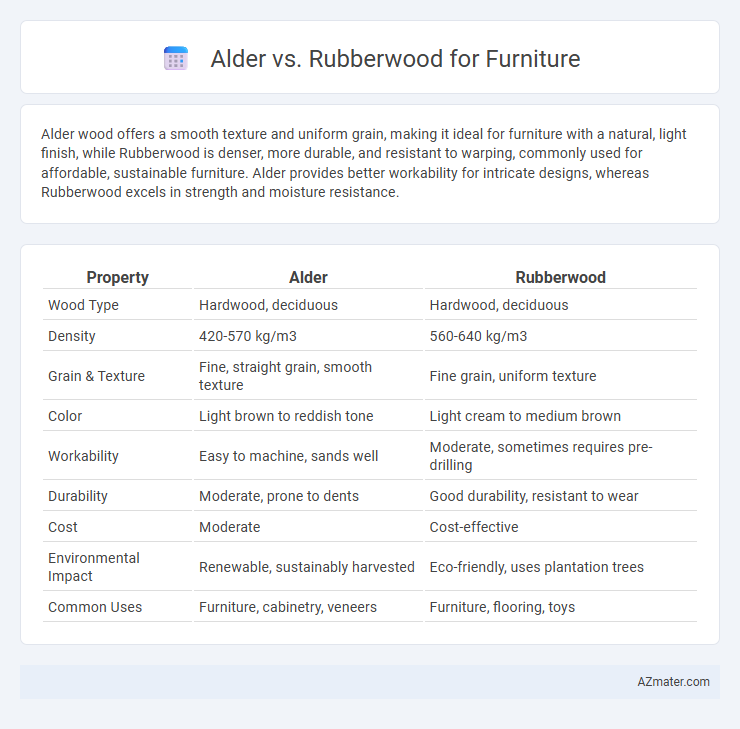Alder wood offers a smooth texture and uniform grain, making it ideal for furniture with a natural, light finish, while Rubberwood is denser, more durable, and resistant to warping, commonly used for affordable, sustainable furniture. Alder provides better workability for intricate designs, whereas Rubberwood excels in strength and moisture resistance.
Table of Comparison
| Property | Alder | Rubberwood |
|---|---|---|
| Wood Type | Hardwood, deciduous | Hardwood, deciduous |
| Density | 420-570 kg/m3 | 560-640 kg/m3 |
| Grain & Texture | Fine, straight grain, smooth texture | Fine grain, uniform texture |
| Color | Light brown to reddish tone | Light cream to medium brown |
| Workability | Easy to machine, sands well | Moderate, sometimes requires pre-drilling |
| Durability | Moderate, prone to dents | Good durability, resistant to wear |
| Cost | Moderate | Cost-effective |
| Environmental Impact | Renewable, sustainably harvested | Eco-friendly, uses plantation trees |
| Common Uses | Furniture, cabinetry, veneers | Furniture, flooring, toys |
Introduction to Alder and Rubberwood
Alder is a hardwood prized for its smooth grain and moderate durability, making it ideal for affordable, lightweight furniture with a warm, reddish-brown hue. Rubberwood, sourced from the Para rubber tree, is known for its eco-friendly sourcing and pale color, offering a sustainable option with a fine, consistent grain suitable for a variety of furniture styles. Both woods balance cost-effectiveness and aesthetic appeal, but differ in density and environmental impact, influencing their applications in furniture making.
Origin and Sources of Alder and Rubberwood
Alder wood primarily originates from North America, especially the United States and Canada, thriving in moist, temperate forests where it grows rapidly and sustainably. Rubberwood, also known as Parawood, comes mainly from Southeast Asia, particularly Thailand, Malaysia, and Indonesia, harvested from rubber trees that have completed their latex production cycle. The renewable source of Rubberwood makes it an eco-friendly option, while Alder's North American roots contribute to its popularity in traditional and contemporary furniture manufacturing.
Appearance and Grain Patterns
Alder wood features a light, warm honey-brown color with subtle, straight grain patterns that create a smooth and uniform appearance ideal for modern and rustic furniture designs. Rubberwood, on the other hand, displays a pale cream to light brown hue with a more pronounced, straight to slightly wavy grain, offering a clean and consistent texture suitable for versatile furniture styles. Both woods present appealing grain aesthetics, but alder tends to showcase a finer, more subdued grain, while rubberwood highlights a slightly bolder, more varied pattern.
Durability and Strength Comparison
Rubberwood offers superior durability and strength compared to Alder, making it more suitable for high-traffic furniture pieces. Rubberwood is denser with a Janka hardness rating around 980, while Alder ranks lower at approximately 590, indicating rubberwood's enhanced resistance to dents and wear. This hardness difference positions rubberwood as a robust choice for long-lasting furniture, especially in environments subject to frequent use.
Workability and Ease of Crafting
Alder wood is favored for furniture making due to its excellent workability, featuring a fine, even grain that sands smoothly and takes paint and stain evenly, making it ideal for intricate designs. Rubberwood, while also relatively easy to work with, tends to be harder and denser, requiring sharp tools and more effort for cutting and shaping but provides good durability and resistance to wear. Both woods are suitable for crafting, with alder preferred for detailed woodworking and rubberwood for sturdier, more utilitarian furniture pieces.
Environmental Impact and Sustainability
Alder wood is often praised for its rapid growth rate and renewable qualities, making it a more sustainable choice compared to rubberwood, which is harvested from plantation trees reaching the end of their latex-producing life cycle. Rubberwood capitalizes on reusing timber that would otherwise be discarded, reducing waste and promoting circular economy principles in furniture production. Both woods have lower environmental footprints than tropical hardwoods, but rubberwood's role in repurposing plantation trees offers a notable advantage in eco-friendly furniture manufacturing.
Cost and Affordability
Alder wood is generally more affordable than rubberwood, making it a popular choice for budget-conscious furniture buyers. Rubberwood offers durability and resistance to pests but comes at a slightly higher price due to its sustainable sourcing from rubber tree plantations. Cost-conscious consumers prioritizing affordability often select alder for its balance of quality and lower price point.
Finishing and Maintenance Needs
Alder wood offers a smooth surface that absorbs stains evenly, making it ideal for achieving rich, uniform finishes, while its softer nature requires gentle handling during maintenance to avoid dents and scratches. Rubberwood, known for its tight grain and density, takes paint and varnish well, resulting in durable finishes that resist wear from frequent cleaning. Both woods demand regular dusting and occasional polishing, but rubberwood's higher resilience makes it preferable for furniture exposed to heavier use.
Common Uses in Furniture Design
Alder wood is commonly used for furniture pieces that require a smooth finish and fine detail, such as cabinets, dressers, and moldings, due to its soft texture and easy staining properties. Rubberwood is favored in production furniture and eco-friendly designs because it is durable, sustainable, and resistant to warping, making it ideal for chairs, tables, and shelving. Both woods are popular in furniture design but differ in aesthetic appeal and structural strength, with alder offering warmer tones and rubberwood providing cost-effective resilience.
Which Wood is Better for Your Furniture?
Alder wood offers a smooth texture and warm, reddish-brown hue that enhances indoor furniture with its fine grain and ease of staining, making it ideal for cabinetry and decorative pieces. Rubberwood, known for its sustainability and durability, features a tighter grain and lighter color, which is resistant to warping and commonly used in eco-friendly furniture production. Choosing between alder and rubberwood depends on whether you prioritize aesthetic warmth and refinement (alder) or environmental sustainability and structural strength (rubberwood).

Infographic: Alder vs Rubberwood for Furniture
 azmater.com
azmater.com